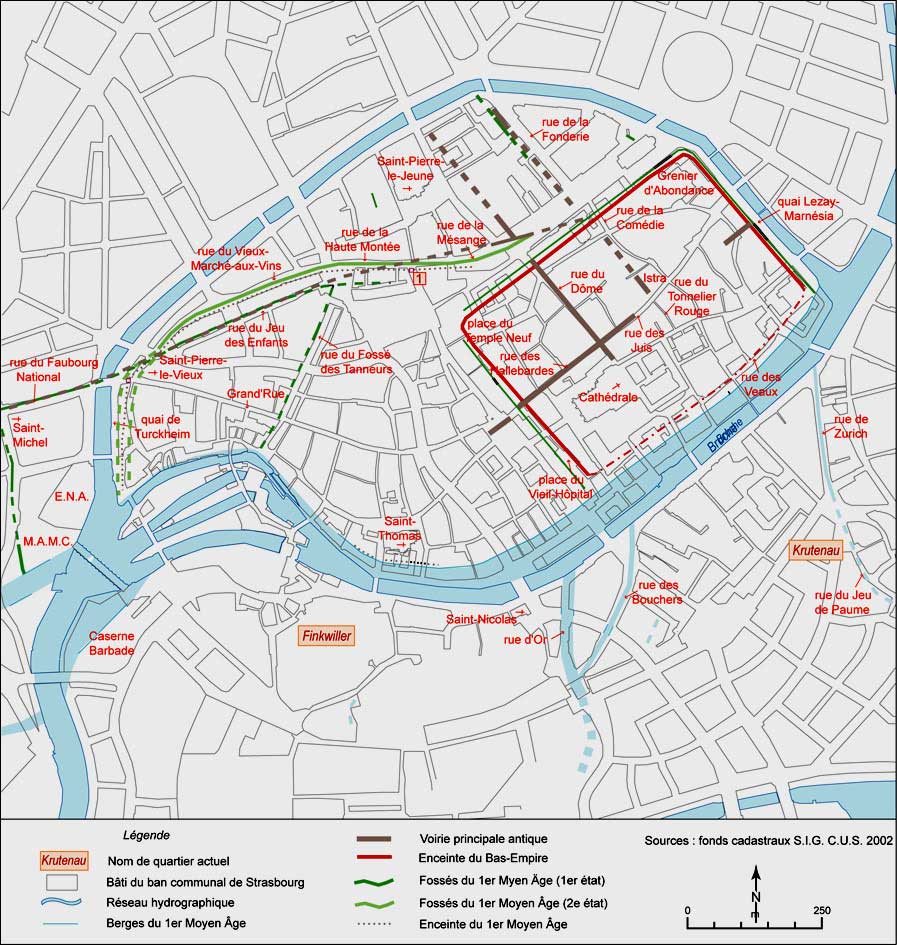The districts’ names (part 2/4)
– The city center
10 mai 2019, par Leo
In a previous article (Part 1/4 – diverse origins), we quickly focused on the origins of the districts’ names. After that first overview, I suggest we take a closer look into the districts’ names in the city center: the Castrum, the Great Island, the Finkwiller and the Hospital district.
The Castrum
The history of the city, situated on the delta of the Ill river, starts with a Roman camp, that we often mention during our guided tours as the starting point of a long urban epic. And that Roman camp left traces that you can still see today: you may read in a booklet or in a description about the “Castrum”.
What we refer to here is the district around the cathedral that still follows the original limits of the Roman military camp called Argentoratum. Incidentally, old and now-covered canals dug by that civilization of pharaonic impact (or should I say Caesar-ic?) would mark its edges. The picture gives an estimated image of the said castrum. Next time you pass by the Broglie square, you shall see that line of buildings in a whole different way…
The Grand Island
The fall of the Roman Empire marks the introduction in a new chapter for Strasbourg: Argentoratum lies in ashes, long live the medieval city of Strate Burgum! A transition that does not go unhindered. But we have here a city that grows until it occupies the whole “Great Island“, the greatest of the many islands formed by the branches of the Ill river. This is now the heart of our beautiful Strasbourg, whose ventricles are the shelters of our afternoons spent in urban strolls.
The Finkwiller
But the expansion does not stop here. Soon, we invest the outskirts of the city and we link to Strasbourg what we now call the “Finkwiller”, south of the Tanners district (also called the Petite France – Small France). That tiny Finkwiller district also bears an old name: Winkwilre, the Hamlet of Finches (Wink, later on Fink, the finch, and Wilre or Willer, the village, the hamlet). Inhabited at first by fishers and mostly by gardeners, it was offered its surname thanks to the vacationing finches.
The Civil Hospital district
The city also equips itself with large infrastructure, part of it being a hospital worthy of the name. A stone’s throw from our cathedral, the street of the Old Hospital can still be found today and has been here since the destruction of the first version of a place where we would gather the sick, the poor, the penniless, the nearly-dead old men and the episodic pilgrim desperate for a roof.
But one epidemic too much was the start of the investment in a larger structure, that would be specifically located outside the city: these are the beginnings of the hospital where we can still see it today, south of the Finkwiller. That hospital, whose history is a tumultuous one, gives its name to the district that surrounds it, between two branches of water: the “Hospital district“, a small town within the town.
The Little France (“Petite France”)
But what about the “Petite France“, the Small France, that iconic name of a district that has been described for two hundred years as so quaint and typical, a stroll of choice for those aimlessly wandering with souls as poems? Well, go on and join our special “Petite France Tour” and our guide will tell you the story…




